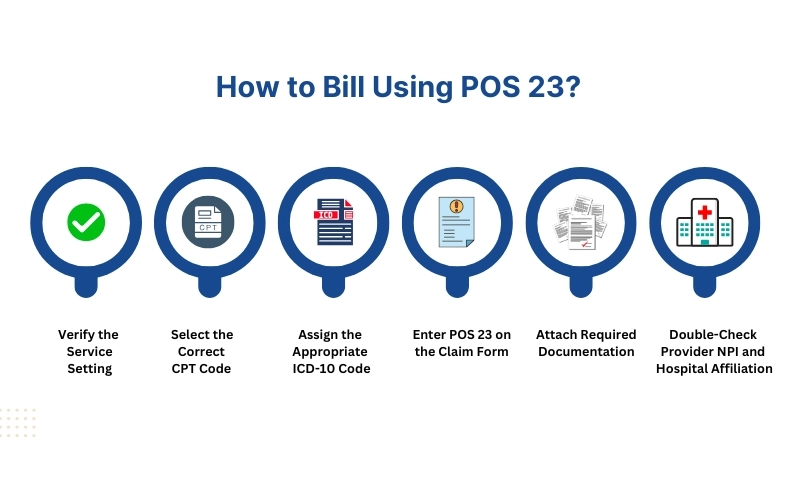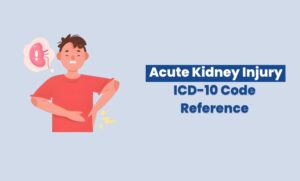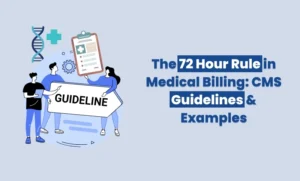In medical billing, every code tells a story; a story of where, how, and why care was delivered. But among the dozens of place of service codes, POS 23 often stands out as one of the most misunderstood. If you’ve ever wondered when to use it, what it means for reimbursement, or why claims with POS 23 sometimes get denied, you’re not alone.
POS 23, officially defined by CMS as “Emergency Room Hospital,” is more than just a billing code; it’s the key to accurate reimbursement for emergency care services. Getting it wrong can lead to underpayments, compliance issues, and unnecessary claim denials.
Getting it right, however, ensures that your emergency department claims are fully compliant, properly documented, and paid on time.
What Is POS 23 in Medical Billing?
In medical billing, POS 23 stands for “Place of Service 23 – Emergency Room (Hospital)”. According to the Centers for Medicare & Medicaid Services (CMS), it refers to a portion of a hospital where emergency diagnosis and treatment of illness or injury are provided.
In simple terms, POS 23 is used when a healthcare provider renders services to a patient inside a hospital’s emergency department. This setting must be part of a licensed hospital facility that operates 24/7 to handle medical emergencies, ranging from accidents and acute illnesses to life-threatening conditions.
Unlike urgent care or outpatient clinics, hospital ERs are equipped for immediate, high-intensity interventions, and billing them under POS 23 signals this elevated level of care to payers. Correct usage ensures providers are reimbursed appropriately for the resource-intensive environment in which the care was delivered.
Example:
If a patient arrives at a hospital ER with severe chest pain and is examined by an emergency physician, all services provided during that encounter, diagnostics, evaluation, and treatment, are billed using POS 23.
POS 23 Description and Scope
POS 23 is exclusively assigned to services performed within a hospital’s emergency room, and only those services. This includes situations where a patient seeks immediate medical attention due to acute symptoms, injury, or any condition requiring urgent evaluation.
To qualify for POS 23, the location must:
- Be a licensed hospital’s emergency department.
- Operate 24/7, providing immediate care to patients.
- Be staffed by qualified emergency physicians and support personnel.
- Have full access to diagnostic imaging, laboratory services, and resuscitation equipment.
It’s essential to remember that freestanding emergency rooms, urgent care clinics, and private facilities do not qualify for POS 23, even if they provide similar services. Misusing this code can lead to claim denials, audits, or even compliance violations.
Because emergency departments handle high-complexity cases requiring immediate intervention, POS 23 claims generally receive higher reimbursement rates than outpatient or office-based visits.
POS 23 vs. POS 21 vs. POS 22: Key Differences
Confusion between hospital-based POS codes is common, especially among new medical billers. Let’s clear it up with a quick comparison:
| POS Code | Name | When It’s Used | Setting Type |
| POS 21 | Inpatient Hospital | When the patient is formally admitted for overnight or extended care | Facility (Inpatient) |
| POS 22 | On-Campus Outpatient Hospital | When services are provided to patients not admitted, but treated within hospital campus | Facility (Outpatient) |
| POS 23 | Emergency Room – Hospital | When services are rendered in a hospital’s ER for acute or emergent conditions | Facility (Emergency Room) |
- POS 21: Admission-based, continuous inpatient care.
- POS 22: Non-emergency outpatient services on hospital grounds.
- POS 23: Emergency diagnosis or treatment within the hospital ER.
Always verify the patient’s location and admission status before assigning a POS code. Using POS 23 for non-ER services can result in denied or underpaid claims.
CMS POS 23 Guidelines
The Centers for Medicare & Medicaid Services (CMS) maintains the official POS Code Set that defines when and how each code should be used. According to CMS, POS 23 applies strictly to emergency services provided within a hospital’s emergency department.
To comply with CMS standards, make sure your billing team follows these core guidelines:
- Confirm the location: The service must occur in a licensed hospital ER.
- Ensure provider eligibility: The billing provider must be authorized to work in that ER setting.
- Match documentation to emergency care: Medical records should reflect the urgency of the situation, symptoms, time of presentation, interventions, and patient outcome.
- Use correct CPT and ICD-10 codes: Pair POS 23 with ER visit codes (99281–99285) and diagnoses that justify emergency-level care.
- Maintain compliance records: CMS and payers often audit POS 23 claims to verify accuracy and necessity.
Failing to meet CMS documentation standards can lead to payment delays, claim denials, or post-payment audits, all of which impact revenue and compliance standing.
Quick Fact:
CMS updates POS codes periodically. Always check the latest CMS POS Code Set for current definitions and effective dates.
How to Bill Using POS 23?
Billing correctly with POS 23 ensures your claims reflect the true level of emergency care provided, and that your organization receives appropriate reimbursement. Here’s a step-by-step breakdown of how to do it right:

Step-by-Step POS 23 Billing Process
1. Verify the Service Setting
Confirm the service was performed in a hospital-based emergency room, not an outpatient clinic or urgent care center.
2. Select the Correct CPT Code
Use CPT codes 99281–99285, which correspond to emergency department visit levels (from low to high complexity).
3. Assign the Appropriate ICD-10 Code
Choose a diagnosis code that supports the medical necessity of the emergency visit (e.g., R07.9 – Chest pain, unspecified).
4. Enter POS 23 on the Claim Form
On the CMS-1500 form, input POS 23 in Box 24B (“Place of Service”).
5. Attach Required Documentation
Include ER physician notes, triage details, time of visit, diagnostic tests, treatments, and disposition (e.g., discharged, admitted).
6. Double-Check Provider NPI and Hospital Affiliation
Ensure the provider’s NPI number is linked to the hospital where services were rendered.
Example Claim
- CPT: 99285 Emergency department visit, high severity
- ICD-10: R10.9 Unspecified abdominal pain
- POS: 23 Emergency Room (Hospital)
- Provider Type: Hospital-based emergency physician
The more complete your documentation, the smoother the claim review process. Always back up your POS 23 claims with evidence of emergency-level service.
POS 23 Reimbursement Rules
Reimbursement for POS 23 is generally higher than for outpatient or office visits, and for good reason, hospital emergency departments require:
- 24/7 staffing and readiness
- High-cost diagnostic and treatment equipment
- Immediate access to physicians and specialists
Payers recognize this resource intensity, so claims under POS 23 are compensated accordingly.
However, reimbursement rates and policies vary among payers:
- Medicare and Medicaid follow CMS-based fee schedules.
- Private insurers may have their own ER billing rules and reimbursement models.
To ensure maximum reimbursement:
- Verify payer-specific POS 23 policies before submission.
- Ensure that CPT, ICD-10, and POS codes align precisely.
- Keep documentation readily available for audits.
Using POS 11 (Office) or POS 22 (Outpatient) instead of POS 23 for emergency care will often result in underpayment, because the claim doesn’t reflect the emergency department’s higher cost structure.
Common POS 23 Claim Denials and Reasons
Even though POS 23 seems straightforward, it’s one of the most frequently misused and denied codes in medical billing. Denials usually happen when documentation doesn’t support the “emergency” nature of the service or when the POS is incorrectly applied.
Here are the most common reasons for POS 23 claim denials:
POS 23 Used in Non-Hospital Settings: If services were rendered in a freestanding emergency room, urgent care center, or outpatient clinic, even if they offer emergency-like care, POS 23 cannot be used.
Solution: Verify that the facility is a licensed hospital emergency department before billing.
Missing or Incorrect Provider Information: Claims often get denied when the billing provider isn’t affiliated with the hospital where the ER services were provided.
Solution: Make sure the provider’s NPI and hospital credentials match the ER setting.
Mismatch Between CPT, ICD-10, and POS: Using non-emergency CPT or diagnosis codes with POS 23 (e.g., a routine checkup code) can trigger automatic denials.
Solution: Pair POS 23 with ER visit CPT codes (99281–99285) and emergency appropriate ICD-10 codes.
Insufficient Documentation: Payers require clear proof that the service met the definition of emergency care. Missing triage notes, timelines, or discharge summaries can raise red flags.
Solution: Maintain complete documentation, including time of service, patient condition, interventions, and outcomes.
Incorrect Provider Type: If the claim is submitted under a non-ER physician (e.g., a family doctor or outpatient specialist) instead of an emergency physician, it may be denied.
Solution: Ensure the provider rendering services in the ER is authorized for that facility.
Best Practices for Accurate POS 23 Billing
Ensuring compliance and maximizing reimbursement starts with consistency, training, and verification. Follow these best practices to improve accuracy and reduce denials:
1. Staff Education and Training
Regularly train billers, coders, and clinical staff on the correct usage of POS codes. Understanding the differences between POS 21, 22, and 23 prevents common mix-ups that lead to denied claims.
2. Implement Billing System Controls
Modern EHR and billing systems can flag incorrect code combinations. Configure automatic alerts for mismatched CPT-POS pairs or non-hospital locations billed under POS 23.
3. Maintain Detailed Documentation
Always include:
- The patient’s presenting symptoms
- Time and date of service
- Provider notes and interventions
- Outcome or discharge status
This documentation supports the emergency classification and safeguards against audits.
4. Conduct Routine Audits
Perform periodic internal or third-party audits to ensure compliance with CMS POS 23 guidelines. Catching issues early helps avoid costly post-payment reviews.
5. Stay Updated with CMS and Payer Policies
CMS updates its POS code set annually. Subscribe to official CMS newsletters or alerts to stay informed about new rules affecting emergency room billing.
POS 23 Summary
| Aspect | Details |
| POS Code | 23 |
| POS Description | Emergency Room – Hospital |
| Defined By | Centers for Medicare & Medicaid Services (CMS) |
| Setting Type | Licensed hospital emergency department |
| Used For | Emergency diagnosis and treatment of illness or injury |
| Common CPT Codes | 99281–99285 (ER visit codes) |
| Documentation Required | ER notes, diagnosis, time of service, interventions, discharge summary |
| Common Errors | Used for urgent care, insufficient documentation, CPT mismatch |
| Denial Prevention Tips | Verify hospital setting, match CPT/ICD-10, confirm provider affiliation |
Summing Up
Accurate use of POS 23 in medical billing ensures that hospital emergency room services are billed correctly, fully documented, and reimbursed at their true value. Misusing this code, even unintentionally, can lead to denied claims, compliance issues, and lost revenue.
Need help ensuring your POS 23 claims are compliant and optimized for reimbursement? Our billing experts from RevenueES can review, correct, and manage your claims for maximum accuracy and faster payments. Get in touch today to safeguard your emergency billing revenue.
FAQ’s
- POS 21 = Inpatient Hospital (admitted care) .
- POS 22 = On-Campus Outpatient Hospital (non-emergency) l.
- POS 23 = Emergency Room – Hospital (acute emergency care).





